rough draft festival lpac beyond sacred unthinking muslim identity
Real-Time. Off Line. Interactive. Online. Theater.
LaGuardia College Performing Arts Center Takes Center Stage With Rough Draft Festival
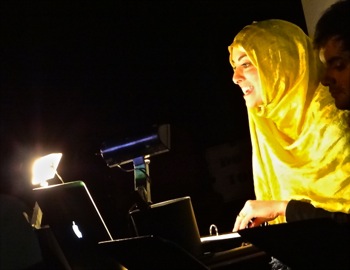 April 13, 2015 / Long Island City LIC / Queens Theater / Queens Buzz.
April 13, 2015 / Long Island City LIC / Queens Theater / Queens Buzz.
A bit more than a week ago I headed down to the LaGuardia College Performing Arts Center to watch / participate in one of the performances of the week-long Rough Draft Festival.
The Rough Draft Festival is the creation of Managing Director Steven Hitt and Assistant Director Handan Ozbilgin of LaGuardia College Performing Arts Center. The festival was the evolution of experimental dance and theatrical work the two had been collaborating on with Queens and New York City performing artists over a number of years. In 2013 they launched the first Rough Draft Festival to attract, audition, present and refine original choreographed and theatrical works probing themes relevant to the Queens community.
The work I would view today was entitled The Art of Hijab. Kohl Black and the Right Way to Pray. This production dovetailed with another project undertaken by the LaGuardia College Performing Arts Center dubbed Beyond Sacred, which is a grant-sponsored exploration of Islamic cultural identity.
Click here to read our report about the Rough Draft Festival at the LaGuardia College Performing Arts Center. Report.
Real-Time. Off Line. Interactive. Online. Theater.
LaGuardia College Performing Arts Center Takes Center Stage With Rough Draft Festival
April 13, 2015 / Long Island City LIC / Queens Theater / Queens Buzz. Continued.
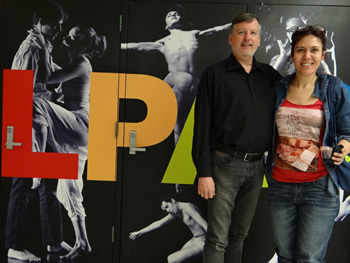 I arrived a bit early at the LaGuardia College Performing Arts Center, where I was guided down one of the back hallways to a side entrance to the Main Theater and onto the main stage. There on the large platform were a few dozen other people who were quietly conversing prior to the beginning of the performance. As I looked around the theater, I found people in the audience ranging in age from the twenties through the fifties.
I arrived a bit early at the LaGuardia College Performing Arts Center, where I was guided down one of the back hallways to a side entrance to the Main Theater and onto the main stage. There on the large platform were a few dozen other people who were quietly conversing prior to the beginning of the performance. As I looked around the theater, I found people in the audience ranging in age from the twenties through the fifties.
As I sat atop the large, elevated expansive stage, there was a subtle good feeling to being here. With each passing year, it occurs to me how much a part of life that story, performance and theater really are. Whether it is the performance of a salesperson to a buyer, the job applicant to the prospective employer, or the production manager or marketing executive to senior management - giving a well scripted, well-choreographed performance is of utmost importance.
LPAC Labs & The Rough Draft Festival At LaGuardia College Performing Arts Center
In the photo above right stand Steven Hitt, Managing Director, and Handan Ozbilgin, Assistant Director of the LaGuardia Performing Arts Center. In 2008 they launched LPAC Labs to enable a number of performing artists including choreographers, writers, producers, directors, dancers and actors / actresses to collaborate at the LaGuardia College Performing Arts Center to evolve their craft. These collaborations spawned a number of original works.
Steven Hitt told me that the LaGuardia College Performing Arts Center was evolving into an incubator of fresh performing arts talent and original theatrical works, some of which is expected to make its way into Off Broadway theaters in Manhattan. The Rough Draft Festival was at the heart of the process, as it gave talent within Queens and NYC an opportunity to refine and show their work to live audiences.
The Art Of The Hijab Mixes Traditional Culture & Modern Technology
 The show started with a woman creating a video on how to put on a hijab. A hijab is an Islamic scarf, and the rectangular scarves provide a plethora of opportunities for a woman to either meld into the background, or add a bit of style to make her hijab a fashion statement. In Islamic culture the Koran mandates that women wear a head covering as a show of modesty. After the show ended, we watched as the 21st century online audience commented on what they liked / didn’t like about the woman’s hijab donning video.
The show started with a woman creating a video on how to put on a hijab. A hijab is an Islamic scarf, and the rectangular scarves provide a plethora of opportunities for a woman to either meld into the background, or add a bit of style to make her hijab a fashion statement. In Islamic culture the Koran mandates that women wear a head covering as a show of modesty. After the show ended, we watched as the 21st century online audience commented on what they liked / didn’t like about the woman’s hijab donning video.
As I watched I recalled that it wasn’t that long ago that Catholic women observed a similar Biblical mandate toward modesty. In the 1960’s American women had to wear hats in church. And I recall my mother telling the story about how she was barred from entering a church in Rome because she wore a skirt that was cut just above the knee. A skirt cut that length would be considered very modest by the American standard of today. American observance of religious traditions changed in the 1960’s and 1970’s, when a rebellious rock and roll culture took root, and shed many of the traditions and shackles of its cultural past.
Islamic Online Dating In America - The Importance Of Cultural Observance
In the next vignette we watched the interactions of an online Islamic dating site based in New York City. We were first shown bios providing age, education, employment and marital status. The basic stats were soon supplemented with stories about how the dating candidates came to this country, and about their experiences finding their respective places in the bastion of democracy and capitalism.
Multi-Cultural Marriage & Cultural Identity Of Progeny
In the next vignette we were whisked away to Tennessee, to a room where the choral group of a Southern Christian Church is rehearsing. It’s Easter time and the reverend begins a lecture about the passion of Christ.
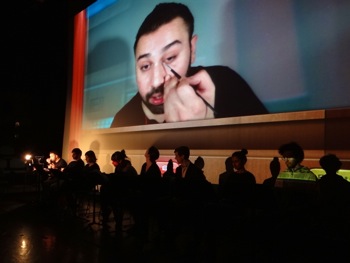 While the church service is in process, a couple of kids in the congregation are thinking [aloud to us] about the Easter Bunny and chocolate Easter eggs. The kids are the children of a mixed religious / cultural couple – one of whom is Christian [mom] and one of whom is Muslim [dad]. The kids engage a youthful, open-minded conversation about their parents' different religious and cultural beliefs, as they try to find their own comfort zones with the different belief systems of their parents.
While the church service is in process, a couple of kids in the congregation are thinking [aloud to us] about the Easter Bunny and chocolate Easter eggs. The kids are the children of a mixed religious / cultural couple – one of whom is Christian [mom] and one of whom is Muslim [dad]. The kids engage a youthful, open-minded conversation about their parents' different religious and cultural beliefs, as they try to find their own comfort zones with the different belief systems of their parents.
Muslim Cosmetics Online Demo - Eye Liner & Eye Shadow Application
As the performance progressed, we began returning to the locales that had been introduced previously [above]. The first return visit was to the online world where a very popular online personality demonstrates to the audience how to put on eyeliner. The role is female, but the character is played by a man. The gender juxtaposition brings greater drama and humor to the performance, which the audience seemed to enjoy - even though the actor was totally serious. After the video performance, we watched as the online audience reacted, with most indicating they enjoyed it, while a few expressed their disapproval.
We then returned to the Christian / Muslim family in Tennessee. The kids’ mother hosts an Easter dinner. The kids discuss the relative merits of certain foods like bacon and pork as the family is awaiting dinner. Pork and bacon are forbidden in Islam, but it's worth mentioning that pork and bacon are also forbidden in Orthodox Judaism, and that eating meat on Fridays used to be forbidden in Catholicism, and that eating beef is forbidden in Hinduism.
American Converts To Islamic Life - Modest Clothing Frees Her From Sexual Identity
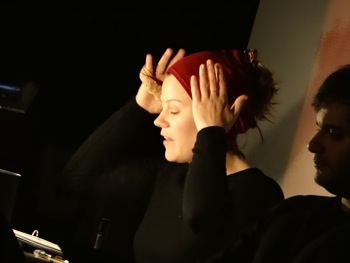 Meanwhile, back online, there’s an American woman who converted to Islam, who is giving a hijab prepping lesson. She talks about how wearing the colorful scarves provides her with a sense of community with the rest of the women wearing them. She tells us she converted to Islam, in part, because of its modesty. Covering up gives her a sense of being clean and of not being looked upon as a sexual object. She tells us she feels closer to god because of it.
Meanwhile, back online, there’s an American woman who converted to Islam, who is giving a hijab prepping lesson. She talks about how wearing the colorful scarves provides her with a sense of community with the rest of the women wearing them. She tells us she converted to Islam, in part, because of its modesty. Covering up gives her a sense of being clean and of not being looked upon as a sexual object. She tells us she feels closer to god because of it.
The converted American woman takes us along on her first hijab wearing occasion, where she felt very much afraid as she went shopping at the local grocery store. People everywhere stared at her, and instead of helping her become more invisible, she felt her hijab [the scarf] had attracted other people’s attention. But she knew she would be ok when an elderly lady approached her and simply said ‘Hi’ in a respectful and friendly manner.
The converted American woman was proud of her faith and not afraid to show it. Wearing that hijab tells people that they must respond to her words and ideas, not her gender. The hijab also tells strangers that profanity isn’t acceptable to her and that she’s someone who will stand up for her beliefs. But that said, while 'hijab' is one of the Arabic words for modesty, it didn’t deflect attention at the American grocery store, but rather attracted it.
Multi-cultural American Children & Ramadan
 We return again to the offline world in Tennessee where the kids are attending an Islamic service at a suburban mosque. The Holy month of Ramadan is ending. Ramadan is the Islamic holiday where Muslims fast for about thirty days to sensitize them to the plight of the poor and starving. The kids talk about how fasting / not eating, clears their minds. They tell us that in Allah’s eyes, all of us are brothers and sisters.
We return again to the offline world in Tennessee where the kids are attending an Islamic service at a suburban mosque. The Holy month of Ramadan is ending. Ramadan is the Islamic holiday where Muslims fast for about thirty days to sensitize them to the plight of the poor and starving. The kids talk about how fasting / not eating, clears their minds. They tell us that in Allah’s eyes, all of us are brothers and sisters.
Their mother is preparing the Ramadan Feast and their father is helping. The mother tells her daughter that wearing the hijab is her decision. Some Muslim women wear the hijab because they are pressured to wear it by their fathers and brothers, while other Muslim women only wear the hijab to prayers, and still other Muslim women wear the hijab to make a fashion statement.
Wearing The Hijab / The Muslim Scarf In America
Wearing a hijab in the United States definitely attracts attention, while wearing the hijab in an Islamic nation does not. We were informed that approximately 80% of the population of Islamic nations are Muslim. Women start wearing the hijab when they reach adolescence, which is also the age at which children become gender-defined. In Islam, women only remove the hijab and show their hair to their family.
Finding Balance ... To Wear Or Not To Wear The Hijab
The young multi-cultural girl in Tennessee tells us that she didn’t like wearing the hijab growing up, but now she likes it. By covering up she is hoping to meet a clear minded man who will respect her for who she is.
 We once again return to the online video world. Some online commentators talk about the hijab as oppressive and that the males in the family pressure them to wear it.
We once again return to the online video world. Some online commentators talk about the hijab as oppressive and that the males in the family pressure them to wear it.
Another commentator says it’s great to cover up a ‘bad hair day’ and that there are many styles of hijabs spanning various Islamic and non-Islamic cultures around the globe. Hijabs [Islamic scarves] and abaya [Islamic dresses] carry meanings that goes beyond the definition of the article of clothing itself - as these words also mean modesty and home / haven / sanctuary, respectively.
Reconciling Cultures: Jesus & Mohamed
Meanwhile back in Tennessee the kids are discussing Jesus and Mohamed. As the kids were born into a family of both the Islamic and Christian faiths, their minds are open to both religions and cultures. While growing up they try to reconcile their parents' ancestral beliefs, traditions and cultures. Since they live in America they question why the genders are separated in the Mosque [men in front and woman in back]. They also discuss the importance of modesty and the feeling of being a part of something bigger than themselves that wearing Muslim prayer clothes imparts.
The Hijab: Outraged American Feminist Point Of View
Back online, there’s a very angry American woman criticizing Muslim culture because of the hijab and emphasis on female modesty. She takes exception to what she sees as husbands repressing their wives. She expresses her supreme frustration with the millennia old multi-cultural concept that a woman having her period is unclean. She views Islam as institutionalized repression and she opines that Islamic cultural modesty usurps a woman of her freedom and identity. In response to her explicit and strident video, a large portion of the online audience disapproves, but there are even more who encourage her rant.
Adapting Adeptly: Muslim Women Make Fashion Statement
This burst of rage is followed by the most popular video performance [millions of views versus hundreds or thousands for all  of the other video shows above]. This woman shows the audience how to make their hijab “sing with bling”. It’s a fun, fashion-savvy video where the woman makes her head look six to ten times bigger than it should look, given her body size.
of the other video shows above]. This woman shows the audience how to make their hijab “sing with bling”. It’s a fun, fashion-savvy video where the woman makes her head look six to ten times bigger than it should look, given her body size.
The video host charms her viewers while enjoying the process of putting on her hijab. She tells her viewers how to make the hijab look appealing, and humorously remarks that men will think that you “have a big brain”. It’s about ‘jungle love’ and ‘fashion pain’ as you walk around carrying this large, heavy, hijab-covered construction on your head. The audience responds enthusiastically.
Embracing An American Way Of Life: Personal Choices & Freedoms
Back in Tennessee the multi-cultural Tennessee kids talk about life in the Middle East. They remark that life is closed to Middle Eastern women, as limits are placed not just on what a woman can wear, but on employment opportunities as well. And in Islam the property is handed down through the male lines.
Brief American History Vis A Vis Women's Rights Beginning 1920
As I listened to this critique of Middle Eastern culture as seen from the theatrical viewpoint of American children, I began thinking about America’s history regarding the treatment of women. Less than a century ago women in America didn’t have the right to vote [in 1920 the 19th Amendment was passed]. And American women were generally confined to ‘female’ professions like nursing, secretarial work and teaching - until the sexual revolution of the 1960’s and 1970’s. In 1960 the female participation rate in the labor force was just over 40%. In today’s America one might think that American limitations on gender roles were centuries or millennia ago, but in fact it was only a few short decades ago.
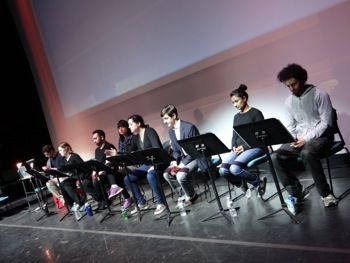 And so the production ended and the audience showered the cast with an approving applause.
And so the production ended and the audience showered the cast with an approving applause.
Post Show Interaction With Writers, Producers, Directors & Actors
The audience, the writers, producers and cast stayed on the stage after the performance ended, and a discussion ensued. Most of the conversation was directed at the writers, as the performance had turned out to be an interesting aperture through which to view an entire culture. They took one piece of clothing – the hijab, a scarf - and used that to explore the cultural differences between Christianity and Islam.
Where did they get the idea? From the online world where there’s a whole sub world of hijab videos.
They were asked why they mixed genders in the roles [males in female roles and vice versa]. They responded that they wanted to give the audience an opportunity to consider how gender affects the way we view / react to things.
 What's been the reaction to the original theatrical performance so far? They told us that we, the current audience, had been fairly subdued in our reactions to the performance. They went on to tell us that the previous night the audience had become quite boisterous because a number of people of Muslim descent had come to watch the show. Some of them were upset by some of the alternative perspectives shown in the performance, but they understood that in the overall context of the show, that the perspectives depicted were meant to portray a variety of viewpoints. They understood that the show was not meant to be disrespectful to Islam in any way - but rather inclusive and thought - provoking regarding cultural differences.
What's been the reaction to the original theatrical performance so far? They told us that we, the current audience, had been fairly subdued in our reactions to the performance. They went on to tell us that the previous night the audience had become quite boisterous because a number of people of Muslim descent had come to watch the show. Some of them were upset by some of the alternative perspectives shown in the performance, but they understood that in the overall context of the show, that the perspectives depicted were meant to portray a variety of viewpoints. They understood that the show was not meant to be disrespectful to Islam in any way - but rather inclusive and thought - provoking regarding cultural differences.
The author of the show expounded on this point noting that the purpose of the show was to stimulate thinking and conversation about cultural differences and similarities, in order to help bridge our understanding of one another.
At the Faces Of Islam art exhibit opening at the Queens Museum in February, which was one segment of the multi-facted Beyond Sacred program, LPAC Managing Director Steven Hitt had told me,
"... we [the LaGuardia College Performing Arts Center] are excited to facilitate a cross-cultural conversation, to broaden our audience and community interaction, and to be there for the community ..."
It's worth noting that nearly 50% of Queens' residential population was born in another country and that over 100 languages are spoken in the borough. It seems Steven Hitt and Associate Artistic Director Handan Ozbilgin have successfully been able to find artistic themes and talent in one of the borough's greatest resources - it's ethnically mixed and culturally diverse population.
Art Should Comfort The Disturbed, And Disturb The Comfortable
Author Cesar Cruz said that,
 “Art should comfort the disturbed, and disturb the comfortable.”*
“Art should comfort the disturbed, and disturb the comfortable.”*
While I’m not sure I am fit securely in either category - disturbed or comfortable - I found The Art of the Hijab at the Rough Draft Festival to be very engaging.
After the program the writer and producer said they would continue developing this play, which they had created for the Rough Draft Festival organized and hosted by the LaGuardia Performing Arts Center. Ultimately neither could comment on where it would take them or where they might go with it next.
Rough Draft Festival & Beyond Sacred: Unthinking Muslim Identity
As mentioned above, LPAC Managing Director Steven Hitt had told me that the goal of the Rough Draft Festival was to spawn new work by supporting the creative process. LPAC Assistant Artistic Director Handan Ozbilgin had told me that the intent of the Beyond Sacred: Unthinking Muslim Identity was to expand people’s understanding of Islamic culture. It seems that with the production of The Art Of The Hijab, they had successfully accomplished both.
Many thanks to the staff of the LaGuardia College Performing Arts Center staff, and the authors, producers, directors and actors, for bravely attempting to bridge the cross-cultural divide and expand our understanding of Islamic culture and theater as art. One need only watch the nightly news to know that we need far more of this.
*Finley Dunne, a 20th century Chicago writer, is credited with the forerunner of this quote as he wrote, "to afflict the comfortable and comfort the afflicted".
Queens Buzz Voluntary Single Copy Sales or Subscriptions
We're not independently wealthy. So if you like what we're doing, you can help us continue to provide you with this coverage and possibly expand it, by voluntarily paying for a single copy or by subscribing to ![]() Queens Buzz. Click button for details on how to make a purchase for as little as $5 which is less than what you'd pay for one issue of a magazine.
Queens Buzz. Click button for details on how to make a purchase for as little as $5 which is less than what you'd pay for one issue of a magazine.
LIC Neighborhood - Long Island City Links
Click on these advertisements for promotions, discounts and coupons by retailers and restaurateurs in Long Island City LIC and nearby Queens. Click here for a related story about the hotels & restaurants in Dutch Kills section of Queens.
Click this link to go to the:
Long Island City Neighborhood or LIC Business Directory
Long Island City Real Estate or Events & Things To Do In LIC
Restaurants In Long Island City or LIC Shops & Shopping
Site Search Tips. 1) For best results, when typing in more than one word, use quotation marks - eg "Astoria Park". 2) Also try either singular or plural words when searching for a specific item such as "gym" or "gyms".
$element(bwcore,insert_search,N)$
Click this link to search for something in our Queens Business Directory.
$element(adman,groupad,Sectional2 Ad)$
Click the log in link below to create an ID and post an opinion.
Or send this story to a friend by filling in the appropriate box below.
















